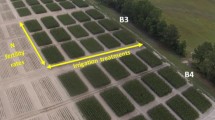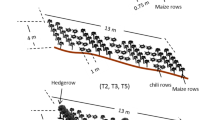Abstract
Sesbania [Sesbania sesban (L.) Merr.] fallows are being promoted as a means for replenishing soil fertility in N-depleted soils of small-scale, resource-poor farmers in southern Africa. Knowledge of soil water distribution in the soil profile and water balance under proposed systems is important for knowing the long-term implications of the systems at plot, field and watershed levels. Soil water balance was quantified for maize (Zea mays L.) following 2-year sesbania fallow and in continuous maize with and without fertilizer during 1998–1999 and 1999–2000 at Chipata in eastern Zambia. Sesbania fallow increased grain yield and dry matter production of subsequent maize per unit amount of water used. Average maize grain yields following sesbania fallow, and in continuous maize with and without fertilizer were 3, 6 and 1 Mg ha−1 with corresponding water use efficiencies of 4.3, 8.8 and 1.7 kg mm−1 ha−1, respectively. Sesbania fallow increased the soil-water storage in the soil profile and drainage below the maximum crop root zone compared with the conventionally tilled non-fertilized maize. However, sesbania fallow did not significantly affect the seasonal crop water use, mainly because rainfall during both the years of the study was above the normal seasonal water requirements of maize (400 to 600 mm). Besides improving grain yields of maize in rotation, sesbania fallows have the potential to recharge the subsoil water through increased subsurface drainage and increase nitrate leaching below the crop root zone in excess rainfall seasons.
Similar content being viewed by others
References
Buresh R.J. and Tian G. 1997. Soil improvement by trees in sub-Saharan Africa. Agroforestry Systems 38: 51–76.
Chirwa T.S., Mafongoya P.L. and Chintu R. 2003. Mixed planted-fallows using coppicing and non-coppicing tree species for degraded Acrisols in eastern Zambia. Agroforestry Systems.
Cooper P.J.M. and Gregory P.J. 1987. Soil water management in rainfed farming systems of the Mediterranean region. Soil Use Management 3: 57–62.
Hillel D., Krentos V. and Styianou Y. 1972. Procedure and test of an internal drainage method for measuring soil hydraulic characteristics in situ. Soil Science 114: 396–400.
Jarvis N.J. and Hignett C.T. 1978. Sources of bias in field calibration of a neutron moisture meter. Australian Journal of Soil Research 17: 405–415.
Jury W.A., Gardner W.R. and Gardner W.H. 1991. Soil Physics. 5th Edition, John Wiley and Sons Inc., New York, 328 pp.
Klute A. 1986. Water retention: Laboratory Methods. In: Klute A. (ed.), Methods of Soil Analysis: Physical and Mineralo-gical Methods, Part 1, (2nd ed.), Agronomy Monograph No. 9. American Society of Agronomy, Madison, WI, pp. 635-662.
Kwesiga F. and Coe R. 1994. The effect of short duration Sesbania sesban planted fallows on maize yield. Forest Ecology and Management 64: 199–208.
Kwesiga F., Franzel S., Place F., Phiri D. and Simwanza C. 1999. Sesbania sesban improved fallows in eastern Zambia: Their inception, development and farmer enthusiasm. Agroforestry Systems 47: 49–66.
Ludlow M.M. and Muchow R.C. 1990. A critical evaluation of traits for improving yields in water-limited environments. Advances in Agronomy 43: 107–153.
Mapa R. and Gunasena H. 1995. Effects of alley cropping on soil aggregate stability of tropical Alfisol. Agroforestry Systems 32: 237–245.
Mualem Y. 1976. A new model for predicting the hydraulic conductivity of unsaturated porous media. Water Resources Research 12: 513–522.
Niang A., Gathumbi S. and Amadoalo B. 1996. The potential of short duration improved fallow for crop productivity enhancement in the highlands of western Kenya: In: Mugah, J. (ed.) People and Institutional Participation in Agroforestry for Sustainable Development. Kenya Forestry Research Institute, Muguga, Kenya, pp. 218–230.
Phiri E. 2002. Soil water dynamics and crop water use for maize and soybean under an agroforestry system of improved sesbania fallow in Zambia. PhD Thesis, University of Gent, Belgium, 185 pp.
Richards L.A. 1949. Methods of measuring soil moisture tension. Soil Science 68: 95–112.
Schroth G., Kolbe D., Pity B. and Zech W. 1995. Searching for criteria for the selection of efficient tree species for fallow improvement, with special reference to carbon and nitrogen. Fertilizer Research 42: 297–314.
Torquebiau E. and Kwesiga F. 1996. Root development in Sesbania sesban fallow-maize system in eastern Zambia. Agroforestry Systems 34: 193–211.
Vachaud G., Royer J.M. and Cooper D. 1977. Comparison of methods of calibration of a neutron probe by gravimetry or neutron capture model. Journal of Hydrology 34: 343–356.
van Genuchten M.Th. 1980. A closed-form equation for predicting the hydraulic conductivity of unsaturated soils. Soil Science Society of America Journal 44: 892–898.
van Genuchten M.Th., Leij F.J. and Yates S.R. 1991. The RETC code for quantifying the hydraulic functions of unsaturated soils. United States Salinity Laboratory, CA, 85 pp.
van Noodwijk M., Midiato M., Heinen M. and Hairiah K. 1991. Old tree root channels in acid soils in the humid tropics: important for crop root penetration, water infiltration and nitrogen management. Plant and Soil 134: 37–44.
Young A. 1997. Agroforestry for Soil Management. CAB International, Wallingford, UK and ICRAF, Nairobi, Kenya.
Author information
Authors and Affiliations
Rights and permissions
About this article
Cite this article
Phiri, E., Verplancke, H., Kwesiga, F. et al. Water balance and maize yield following improved sesbania fallow in eastern Zambia. Agroforestry Systems 59, 197–205 (2003). https://doi.org/10.1023/B:AGFO.0000005220.67024.2c
Issue Date:
DOI: https://doi.org/10.1023/B:AGFO.0000005220.67024.2c




